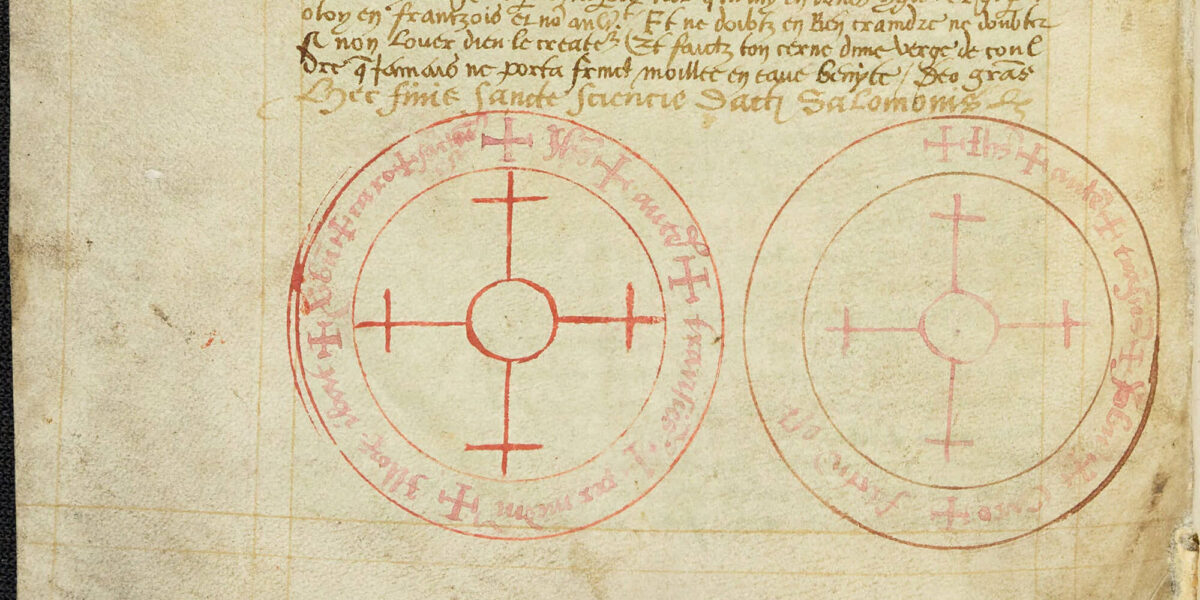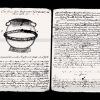The oldest treatise on demonic magic in French, 15th or 16th century
Ms. Cambridge, Trinity College O.8.29
The Livre des Esperitz (or Book of Spirits) is a 15th or 16th century French grimoire that inspired later works including Johann Weyer’s Pseudomonarchia Daemonum and the Lesser Key of Solomon. It is the oldest treatise on demonic magic in French currently in existence. It contains elements dating back to at least the 13th century.
The first part, Livre des Esperitz, is a catalog of 46 demons. It provides detailed descriptions of each spirit’s appearance and function, and lists how many legions of demons serve under each. Many of these descriptions eventually found their way into later works, often unmodified.
After a short introduction explaining the origin of the Livre des Esperitz as it was revealed to King Solomon, the document draws up their nomenclature, then gives a detailed description of the three Archdemons named, Lucifer, Gay / Belzebuth and Satan. This is followed by the four kings who rule the four cardinal directions of the sky, Orient (Oriens), Poymon (Paymon), Amoymon (Amaymon) and Equi ( alias Egyn, which is later forgotten: there should therefore be 47 paragraphs and there a 47 demons and not 46), then, without a hierarchical order being followed in a continuous manner, seven other kings, eight princes, twelve dukes, ten marquis, two counts and a “great lord”.
The second part, Livre des conjuracions, includes the prayers and conjurations to summon and force the demons to obey a practitioner. According to Jean-Patrice Boudet, Livre des conjuracions is a translation-adaptation of a Liber consecrationum which further confirms its age.
In 1577, Johann Weyer published his Pseudomonarchia daemonum as an appendix to his De Praestigiis Daemonum, 1563. Weyer referred to his source manuscript as Liber officiorum spirituum, seu Liber dictus Empto. Salomonis, de principibus & regibus dæmoniorum (“Book of the offices of spirits, or the book called Empto. Salomonis concerning the princes and kings of the demons”). Based on their similarities, Weyer’s source manuscript and Livre des Esperitz are but two distinct versions of the same type of text.
Amongst the spirits found in the Livre des Esperitz are four demons kings, namely, Lucifer, Bezlebuth, Satan, and Orient. These entries are no where to be found in Weyer’s Pseudomonarchia daemonum. Given their demonic stature, these may in fact be the elements that Weyer omitted from his text. In his foreword he states, “But lest anyone who is mildly curious, may dare to rashly imitate this proof of folly; I have omitted passages from this study, in order to render the whole work unusable.”
The full catalog of demons listed within Livre des Esperitz are as follows:
| Lucifer | Duke Drap |
| Gay / Bezlebuth | King Asmoday |
| Satan | Prince Caap |
| Orient | Duke Bune |
| Poymon | Marquis Bitur |
| King Aymoymon, | Duke Lucubar |
| Equi | |
| King Beal | King Bugan |
| Duke Agarat | Prince Parcas |
| Prince Barthas | Duke Flavos |
| Prince Bulfas | King Vaal |
| Marquis Amon | Marquis Fenix |
| Prince Barbas | Marquis Distolas |
| King Gemer | Duke Berteth |
| Duke Gazon | Count Dam |
| Duke Artis | Duke Furfur |
| Duke Machin | Prince Forcas |
| King Diusion | Lord Malpharas |
| Duke Abugor | Duke Gorsay |
| Count Vipos | King Samon |
| Marquis Cerbere | Marquis Tudiras Hoho |
| Prince Carmola | Marquis Oze |
| Marquis Salmatis | Marquis Ducay |
| Prince Coap | Duke Bucal |
Sources Cites: Jean-Patrice Boudet , “The demonological who’s who of the Renaissance and their medieval ancestors”, Médiévales [Online], 44 | spring 2003, posted on December 09, 2005, consulted on October 11, 2020. URL: http://journals.openedition.org/medievales/1019; DOI: https://doi.org/10.4000/medievales.1019




